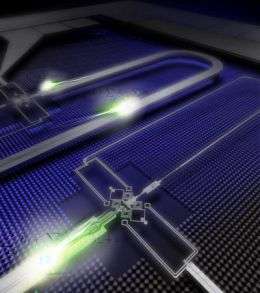NIST Debuts Superconducting Quantum Computing Cable

Physicists at the National Institute of Standards and Technology have transferred information between two “artificial atoms” by way of electronic vibrations on a microfabricated aluminum cable, demonstrating a new component for potential ultra-powerful quantum computers of the future. The setup resembles a miniature version of a cable-television transmission line, but with some powerful added features, including superconducting circuits with zero electrical resistance, and multi-tasking data bits that obey the unusual rules of quantum physics.
The resonant cable might someday be used in quantum computers, which would rely on quantum behavior to carry out certain functions, such as code-breaking and database searches, exponentially faster than today’s most powerful computers. Moreover, the superconducting components in the NIST demonstration offer the possibility of being easier to manufacture and scale up to a practical size than many competing candidates, such as individual atoms, for storing and transporting data in quantum computers.
Unlike traditional electronic devices, which store information in the form of digital bits that each possess a value of either 0 or 1, each superconducting circuit acts as a quantum bit, or qubit, which can hold values of 0 and 1 at the same time. Qubits in this “superposition” of both values may allow many more calculations to be performed simultaneously than is possible with traditional digital bits, offering the possibility of faster and more powerful computing devices. The resonant section of cable shuttling the information between the two superconducting circuits is known to engineers as a “quantum bus,” and it could transport data between two or more qubits.
The NIST work is featured on the cover of the Sept. 27 issue of Nature. The scientists encoded information in one qubit, transferred this information as microwave energy to the resonant section of cable for a short storage time of 10 nanoseconds, and then successfully shuttled the information to a second qubit.
“We tested a new element for quantum information systems,” says NIST physicist Ray Simmonds. “It’s really significant because it means we can couple more qubits together and transfer information between them easily using one simple element.”
The NIST work, together with another letter in the same issue of Nature by a Yale University group, is the first demonstration of a superconducting quantum bus. Whereas the NIST scientists used the bus to store and transfer information between independent qubits, the Yale group used it to enable an interaction of two qubits, creating a combined superposition state. These three actions, demonstrated collectively by the two groups, are essential for performing the basic functions needed in a superconductor-based quantum information processor of the future.
In addition to storing and transferring information, NIST’s resonant cable also offers a means of “refreshing” superconducting qubits, which normally can maintain the same delicate quantum state for only half a microsecond. Disturbances such as electric or magnetic noise in the circuit can rapidly destroy a qubit’s superposition state.
With design improvements, the NIST technology might be used to repeatedly refresh the data and extend qubit lifetime more than 100-fold, sufficient to create a viable short-term quantum computer memory, Simmonds says. NIST’s resonant cable might also be used to transfer quantum information between matter and light -- microwave energy is a low-frequency form of light -- and thus link quantum computers to ultra-secure quantum communications systems.
If they can be built, quantum computers -- harnessing the unusual rules of quantum mechanics, the principles governing nature’s smallest particles -- might be used for applications such as fast and efficient code breaking, optimizing complex systems such as airline schedules, making counterfeit-proof money, and solving complex mathematical problems. Quantum information technology in general allows for custom-designed systems for fundamental tests of quantum physics and as-yet-unknown futuristic applications.
A superconducting qubit is about the width of a human hair. NIST researchers fabricate two qubits on a sapphire microchip, which sits in a shielded box about 8 cubic millimeters in size. The resonant section of cable is 7 millimeters long, similar to the coaxial wiring used in cable television but much thinner and flatter, zig-zagging around the 1.1 mm space between the two qubits. Like a guitar string, the resonant cable can be stimulated so that it hums or “resonates” at a particular tone or frequency in the microwave range. Quantum information is stored as energy in the form of microwave particles or photons.
Citation: M.A. Sillanpää, J.I. Park, and R.W. Simmonds. 2007. Coherent quantum state storage and transfer between two phase qubits via a resonant cavity. Nature, Sept. 27.
Source: National Institute of Standards and Technology





















